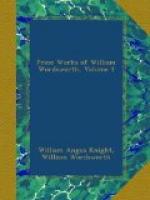Observed in the holly grove at Alfoxden, where these verses were written in the spring of 1799. I had the pleasure of again seeing, with dear friends, this Grove in unimpaired beauty forty-one years after. [The ‘dear friends’ were Mrs. Wordsworth, Miss Fenwick, Mr. and Mrs. Quillinan, and Mr. William Wordsworth, May 18, 1841. Memoirs, i. 112.]
100. *_The Waterfall and the Eglantine_. [IV.]
Suggested nearer to Grasmere on the same mountain track. The eglantine remained many years afterwards, but is now gone. [In pencil on opposite page—Mr. W. shewed me the place 1848. E.Q.]
101. *_The Oak and the Broom; a Pastoral_. [V.]
1800. Suggested upon the mountain pathway that leads from Upper Rydal to Grasmere. The ponderous block of stone, which is mentioned in the poem, remains, I believe, to this day, a good way up Nab-Scar. Broom grows under it, and in many places on the side of the precipice.
102. *_To a Sexton_. [VI.]
Written in Germany, 1799.
103. *_To the Daisy_. [VII.]
This Poem, and two others to the same flower, were written in the year 1802; which is mentioned, because in some of the ideas, though not in the manner in which those ideas are connected, and likewise even in some of the expressions, there is a resemblance to passages in a Poem (lately published) of Mr. [James] Montgomery’s, entitled a ‘Field Flower.’ This being said, Mr. Montgomery will not think any apology due to him; but I cannot, however, help addressing him in the words of the Father of English Poets:
’Though it happe me
to rehersin
That ye han in your freshe
songes saied,
Forberith me, and beth not
ill apaied,
Sith that ye se I doe it in
the honour
Of Love, and eke in service
of the Flour.’
1807. [Note.] See, in Chaucer and the older Poets, the honours formerly paid to this flower.
104. *_To the same Flower_. [VIII.]
‘To the Daisy,’ ‘To the same Flower,’ and ’The Green Linnet’—all composed at Town-End Orchard, where the bird was often seen as here described.
105. *_To the small Celandine_. [XI.]
Grasmere, Town-End. It is remarkable that this flower coming out so early in the spring as it does, and so bright and beautiful, and in such profusion, should not have been noticed earlier in English verse. What adds much to the interest that attends it, is its habit of shutting itself up and opening out according to the degree of light and temperature of the air. [In pencil on opposite page—Has not Chaucer noticed it?] [Note.] Common Pilewort.
106. The Seven Sisters.
The story of this Poem is from the German of Frederica Brun.
107. *_The Redbreast chasing the Butterfly_. [XV.]
Observed as described in the then beautiful Orchard at Town-End.
108. *_Song for the Spinning-wheel_. [XVI.]
1806. The belief on which this is founded I have often heard expressed by an old neighbour of Grasmere.




